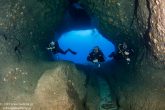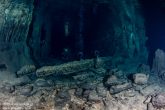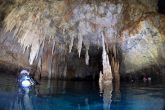Elephants cave
-

The entrance which is also the only exit of the Elephant Cave. -

Huge stalagmites and stalactites formations are developed in much of the cave. Along with the other the findings this comes to prove the cave was dry many thousands of years ago. -

A huge stalagmite withstanding time for millions of years reminding us of other eras. -

The Elephant Cave interior is particularly rich in decoration. Observe the magnitude of the fallen stalagmite versus the divers. -

Before the end of his journey, the diver enters another landscape. The white sand differentiates the color shades making the image surreal. -

In the large hall of the Elephant Cave, with its majestic air pocket, there is the majestic curtain of stalagmites. The joy on the diver's faces is evident after the dive. -

The point where stalagmites and stalactites have come together after millions of years. -

The entire ceiling of the cave is almost completely decorated by small and large stalactites. -

Before the end of the route the diver enters another landscape. The bright white sand differentiates the color shades, making the image unreal. -

The golden sand dominates most of the bottom. Here we see many of the small blind tunnels of the cave. -

The diver as he prepares to surface. -

Video from the elephants cave
Elephant Cave, Crete
At Cape Drepano of the Municipality of Apokoronas under the Red Village, outside the bay of Souda, lies the underwater cave of the Elephants as it is called. The cave was discovered in 1999 by Manolis Efthimakis. After which, the Palaeoanthropology and Speleology Ephorate organized the first cave exploration mission on March the 31st in 2000. The findings were fantastic and of extreme palaeontologic importance. The most important finding was the identification of palaeontological material, whereby, after a first study, were found to consist mostly of elephant and a very small percentage of deer (Cervidae) bones. From the measurements taken from parts of the elephant skeleton, it has been possible to support this is a new species, called Elephas chaniensis, from the Chania region. Its size was larger than the current elephant and smaller than its ancestor, antiquus. The fossils from the elephants belonged to at least three adults and a younger member, apparently an endemic species. Elephas Chaniensis was three meters tall and although he had no remarkable differences from the African and Indian Elephants, he had thicker bones and a tougher built body.
The age is thus far estimated to be between 50,000-60,000 years. The migration of these species to Greece is determined to have occurred 15 million years ago when there was a single land from the Ionian region to the coasts of Asia Minor. It is believed that the excessive increase in the deer population (which is very similar to today’s goats) had greatly reduced food stocks, leading to the extinsion of the region’s elephants. This is confirmed by the fact that in the cave, the bones of elephants were found in lower layers than the deer counterparts and other smaller mammals.
Information about the cave.
The entrance of the cave is located 9 meters above sea level. During the first 40 meters or so the diver enters a spacious tunnel, which will lead him to the main cave, which is flooded with water. At that point, an observant diver will notice the small bone remains from the ancient elephants, from which the cave’s name derives. In these first meters, there are no formations that prepares the diver for the spectacle to follow. Entering the main cave we see large stalactite and stalagmite formations, which in many places exceed 8 meters in height. The cave starts and develops at an angle of 45 degrees to the left, in relation to its original tunnel and almost along its entire length that exceeds 100 meters there are large air chambers. In many places the depth of the water does not exceed 2 meters while large parts of the bottom are covered by a crystal clear golden sand. Also distinct are the haloclines created by the mixing of seawater with spring water which reaches the cave. Nevertheless, its temperature is not significantly affected and is kept close to sea water levels. Also strong is the presence of rocks with intense dark color almost black and strongly affects the divers visibility. Near the end of the cave, two large formations of stalactites and stalagmites can be observed on both sides, these have joined and create a spectacular single wall with brown shades. In general, the decoration of the cave takes the visitor’s breath away and travels his imagination back many millions of years ago when the cave was still above-ground providing shelter for dozens of animals. Although cave diving is a difficult and dangerous type of diving, this cave, due to its large dimensions, shallow depth, the existence of air chambers with breathable air and easy entry / exit, make it a safe destination even for open water divers. Especially when accompanied by Chania Diving Center and its owner instructor Nikolas Giannoulakis, the tour becomes easy and remains a strong memory for every visitor.

